
The main purpose of a marketing report is to help you track campaign performance and guide you in the right direction that stays in your client’s best interest. But do you know how to get started with making a good report, and what you should include in it? Read this guide to learn more.
What are Marketing Reports?
A marketing report is a document that contains insights, data, and analysis of your marketing efforts. Using this report, you and your clients can make informed marketing decisions and even track performance.
7 Important Benefits of Creating Marketing Reports
As a marketer, you do meaningful work for your clients. Marketing reports give you a chance to showcase that! It can help your agency grow since it’s a way to sell clients new ideas you have for your campaigns based on results you can show them.
Make sure you and your client have a clear goal you’re working toward. Utilize reports as a way of gauging progress toward meeting these goals.
Here are some important benefits of creating a marketing report:

1. Proves you’re worth it
Showcase your worth to clients. Let them know their money is being put to good use. If they see you’re making them money or are bringing them lots of followers, they’ll be more likely to stick with you.
2. Everything’s in one place
Rather than your clients having to fish for information themselves, reports give them one thing to look at. It’ll also be easier to show them why they’re being asked to pay for certain things if they see that it’s helping them.
3. Plans for the future using data
Marketing reports give you a way to know if you’re meeting your marketing objectives. Without them, you won’t easily be able to tell if your time and effort are paying off. You’ll be able to see what’s working and what’s not, enabling you to make smarter decisions in the future by learning from your mistakes.
4. Tracks KPIs without any hassle
As a marketer, you need to access your KPIs regularly. A marketing report can make this process simple. You can include KPIs across different platforms like social media, SEO, paid ads, and email.
5. Offers customers what they look for
Knowing at what stage your customers are, is important. A marketing report is a document of high-quality data that contains the details of the customer journey. You can look at exactly where your customers are in their buying journey and target your marketing efforts accordingly.
6. Don’t have to make the hard choices
The tiresome part of being a marketing professional is making marketing reports with the right KPIs. Today, marketing tools like ViewMetrics have made your job easy by automating the task of creating client marketing reports.
7. Smoothens the data flow process across teams
Reaching your client’s business goals with your marketing efforts can happen when the data flows smoothly across teams. With the help of marketing reports, you can keep the data flowing from the marketing team to the sales team.
For example, if in the middle of the campaign, the sales team finds that they’re not reaching the ideal revenue, they can pass the marketing report to the marketing team who can look into it and make adjustments in their marketing efforts accordingly.
Save Time, Reduce Errors, and Make Data-Driven Decisions with Ease!
Questions to Ask Before Creating Marketing Reports
1. Why am I creating this report?
Was your campaign a success or a failure? Are you providing a progress update on a campaign or evaluating the campaign as a whole after it’s been completed? Knowing why the report is being created will make it easier to figure out what to include in it and how to present it.
2. What am I presenting?
When making a marketing report, make sure you have a clear vision of what you want to present. This should include the KPIs you want to track. Moreover, when presenting this report to your clients, avoid giving them unnecessary insights and just keep the report simple and relevant to avoid losing their attention.
3. Who am I presenting to?
Know your audience! A presentation to a restaurant owner will be vastly different from a presentation to a social media influencer or the CMO of a large company. They most likely all want to know different things and expect data to be presented to them in a way they understand and find useful.
Keep that in mind when figuring out what you want to include in a report to them and present it to them in a way that suits their “skill level”.
4. Did I meet my goals or not?
Ultimately, this is the most important question to ask yourself. Don’t worry, even if your goals were not met, still share your learnings. Include meaningful data that can be used to evaluate your efforts, don’t just include data for the sake of having something to report.
Clients want to see that you’re working towards or have already met your goals. Showcase that to them in the easiest way possible for them to understand
5. How am I presenting the report?
Apart from the who, what, and why, another aspect to keep in mind when creating a marketing report is how to make it more visually appealing. To make your marketing report more impactful, you don’t just need to present the facts and figures but also build a story around it to keep your clients interested.
But simply adding pie charts and bar graphs isn’t going to cut it. You need to make it more impactful by aligning your marketing report with your goals, highlighting key data points, and using consistent design language when presenting the data.
How Often Should I Create and Present Marketing Reports?
No, “as frequently as I’d like to” isn’t the right answer, sorry. You don’t want to burn out your clients. If you send them reports too often, they may not read them. You’d be wasting both your time and theirs. Your clients are busy too! Here are three options for how often you should do a Marketing Report:
1. Monthly
Monthly reports are best suited for tracking incremental progress. Campaigns with tighter budgets and social media campaigns can be reported every month. You need to have enough time to truly assess if your campaign is working. Don’t forget to take seasonal trends into account.
If your client is in the eCommerce industry, chances are their revenue spikes during holiday seasons. It may not make sense to compare November with December for them, because their December numbers may be way higher than the average.
2. Quarterly
Most likely reporting quarterly will give you enough time to evaluate the success of some of your larger goals. A quarterly report can tell you if a long-term campaign is successful. For example, you can evaluate the efficacy of a seasonal campaign in increasing revenue and engagement.
This also gives you a chance to regroup and reset your goals every three months. Your goals at the beginning of the year may be different from your goals toward the middle and end of the year. Quarterly goals give you a way to see if you’ve met your goals during those three months.
3. Annually
In addition to providing monthly and/or quarterly reports, you should also provide an annual Marketing Report. Review your work for the entire year and showcase the impact your campaigns had on your client’s business.
Companies can also use this to assess ROI for the year when determining a marketing budget for next year. This is a great way to demonstrate your worth and potentially have more money to work with for next year!
Here’s a table to help you understand the frequency of sending marketing reports to your clients based on the marketing channels:
| Type of Marketing Report | Type of Marketing Campaign | Examples | Purpose of the Marketing Report |
|---|---|---|---|
| Daily Report | Paid Ads, Social Media | Google Ads, Facebook Ads, Instagram Stories | Real-time performance tracking, ad-spend, and engagement details for immediate adjustments. |
| Weekly Report | Content Marketing, Email Marketing | Blog traffic, Email Open Rates, Social Media Posts | Monitoring short-term trends, content effectiveness, and engagement. |
| Bi-Weekly Report | SEO, Influencer Marketing | Backlink Growth, Keyword Rankings, Sponsored Posts | Evaluating strategies and identifying areas of improvement. |
| Monthly Report | Multi-Channel Campaigns, Lead Generation | Organic Traffic, Landing Page Conversions, Webinar Sign-Ups | Allocating budget and assessing overall ROI and marketing performance. |
| Quarterly Report | Brand Awareness, Retention Campaigns | Loyalty Programs, PR Campaigns, Customer Surveys | Providing insights into customer retention, long-term trends, and campaign effectiveness. |
| Annual Report | Overall Marketing Strategy | Revenue Growth, Yearly Website Traffic, Customer Acquisition Cost | Reviewing yearly performance, refining existing strategies, and setting future marketing goals. |
What Should Be Included in a Marketing Report?
The content of a marketing report largely depends on its purpose. Whether you’re focusing on social media, paid advertising, SEO, or evaluating the overall performance of a campaign.
Each report should clearly present the key metrics, meaningful insights, and actionable recommendations that align with your marketing objectives.
Let’s break it down by the type of marketing channel and explore the essential KPIs to include in each report with the following marketing report examples:
Overall Marketing Report
This type of marketing report contains an overall view of all the marketing activities happening on different channels, including SEO, paid campaigns, content marketing, email marketing, and social media campaigns. The KPIs to focus on are:
- Campaign performance
- Bounce rate
- Conversion rate
- Channel performance (website traffic, paid traffic, organic traffic, referral traffic)
- Completion of goals
Use the Template: Monthly Marketing Report Template
PPC/Paid Marketing Report
Monitoring and optimizing paid marketing campaigns regularly is necessary as your client’s money is heavily invested in it. Hence, regularly updating your clients with PPC marketing reports is crucial. Here are the KPIs to include:
- Revenue
- Clicks and costs
- Number of leads generated
- Ad performance
- Lead conversion
Use this Template: Facebook Ads Performance Overview Report Template
SEO/Organic Marketing Report
Organic marketing is a long-term strategy and keeping your clients updated is important. While you may already be using Google Analytics for tracking your SEO efforts, you still should be sending a detailed marketing report with the following KPIs:
- Landing page conversions
- Organic website sessions
- Organic conversions
- Keyword rankings
Use this Template: Basic Google Analytics Report
Social Media Marketing Report
Social media runs on both paid and organic traffic. And if you have clients running campaigns for both paid and organic, you should provide them with social media marketing reports containing the following KPIs:
- Likes and follows
- Reach and impressions
- Audience demographics
- Top performing posts
- Profile engagement rate
Use this Template: Social Media Overview Template
Email Marketing Report
Your email marketing campaigns should always have a purpose to ensure you are driving in the right direction. Tracking these campaigns is important and below are the KPIs to include in your email marketing reports:
- Unique open rate
- Emails sent
- Click rate
- Overall email campaign performance
Use this Template: Mailchimp Campaign Funnel Report Overview Template
How to Present a Marketing Report?
After gathering all this data, now’s the time to present it! Presenting a simple Excel Spreadsheet may be easy but it is also boring. You need to make important information pop out and be easily visible to your client.
Here are some tips to go about it:
1. Add graphics to make it visually appealing
Make graphs and charts your best friend! Your clients are probably tired of seeing the facts and figures presented in boring digits. It’s time to make them visually appealing with graphics.
2. Include results (the good and the bad)
Whether the results of your marketing efforts were good or not as expected, you need to include them all in your marketing report. Stay transparent as not only your clients but also you get an idea of what worked and what didn’t so you can optimize accordingly.
3. Keep it short and sweet
The best marketing report is where you can accurately have figures and data represented while keeping the report short.
4. Include section headers
The last thing you want your client to do is get frustrated over how unorganized your marketing report looks with just numbers filling each page. Increase the readability of your report by including headings, subheadings, and bullet pointers. Highlight the data and figures where necessary.
How View Metrics Can Help You to Create Marketing Reports?
Marketing reports are the heart of any marketer’s marketing efforts. They help you create campaigns and optimize them accordingly. While a good report is a necessity, it can get tiresome to manually create it. Skip this with the help of ViewMetrics!
- Generate Reports in a Snap: Create up-to-the-minute spreadsheets and presentations with ease.
- Smooth Integration: Add charts directly to your go-to project management tools without a hitch.
- Simplify Client Handling: Keep reports tidy with organized workspaces and user-friendly dashboards.
Work smarter by automating client reports now
Get Started for free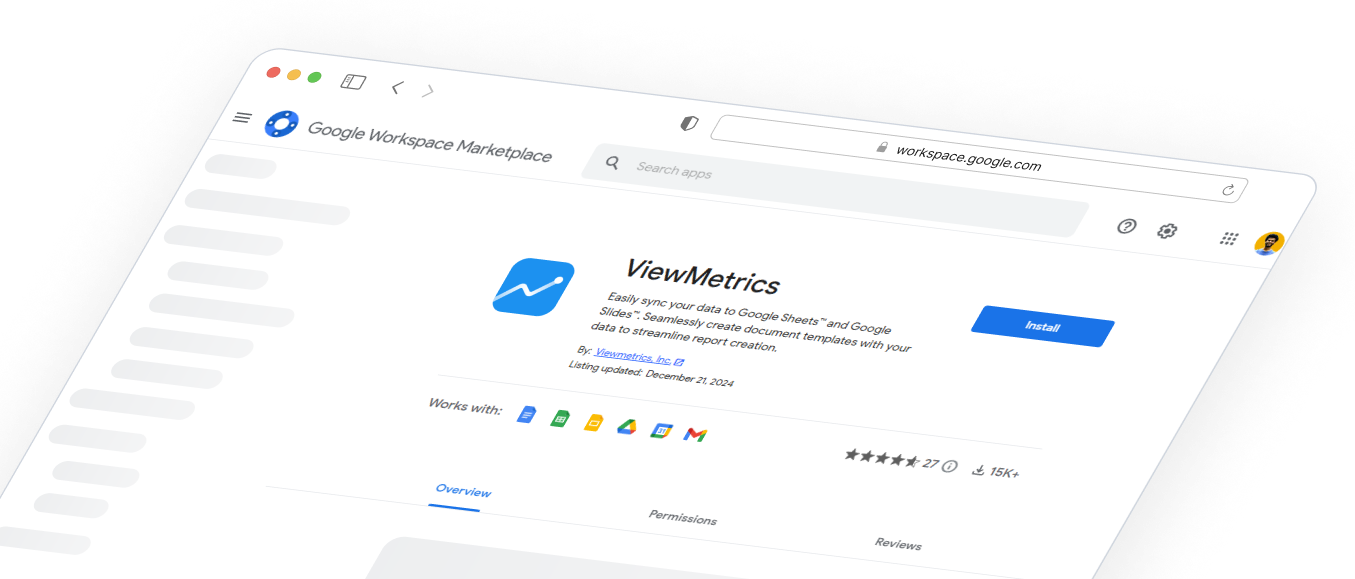
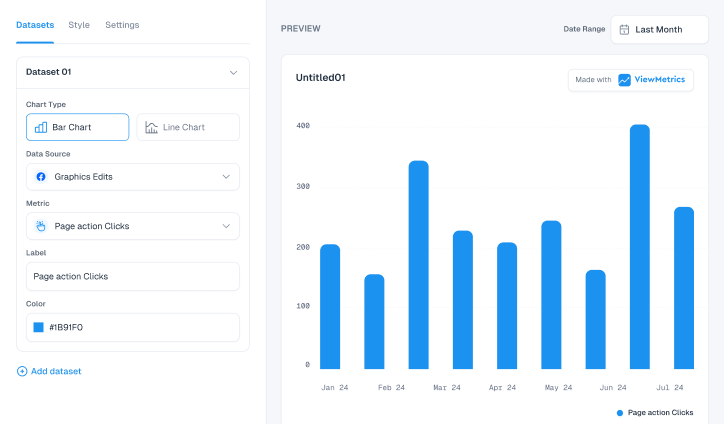
Design That Stands Out
Elevate visuals effortlessly with customizable styling options tailored to match brand aesthetics.
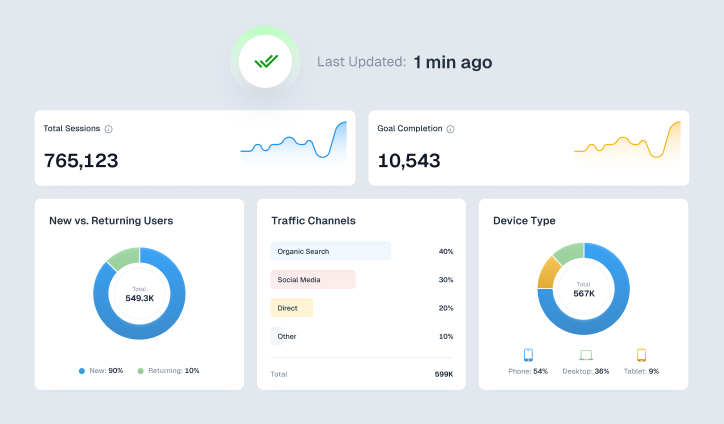
Effortless Data Syncing
Keep insights up-to-date with seamless and flexible data synchronization across platforms.
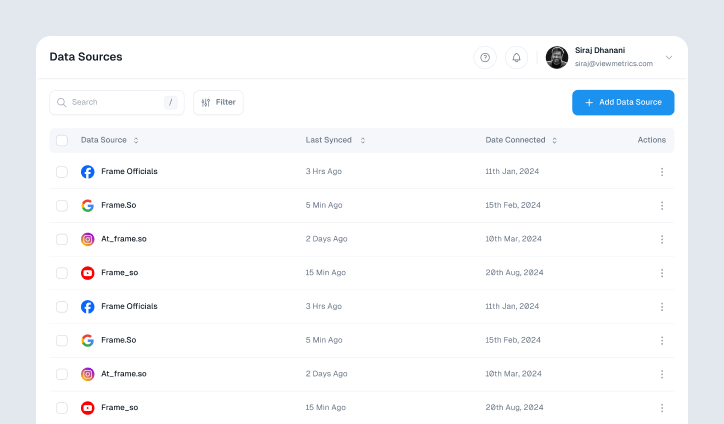
Connect with Ease
Integrate effortlessly with leading platforms to streamline workflows and maximize efficiency.
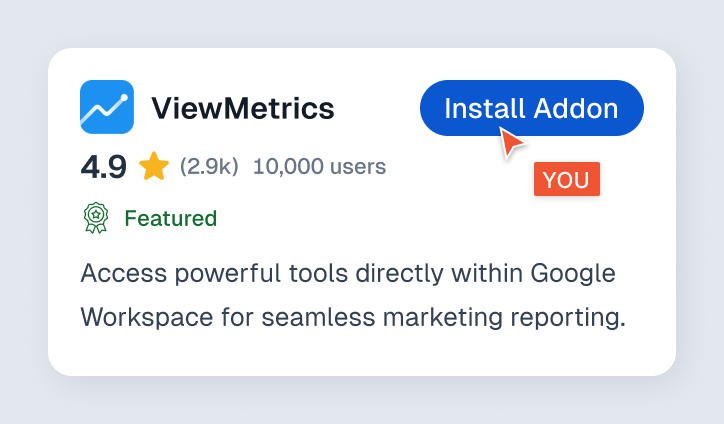
Boost Productivity with Google Add-On
Access powerful tools directly within Google Workspace for seamless marketing reporting.
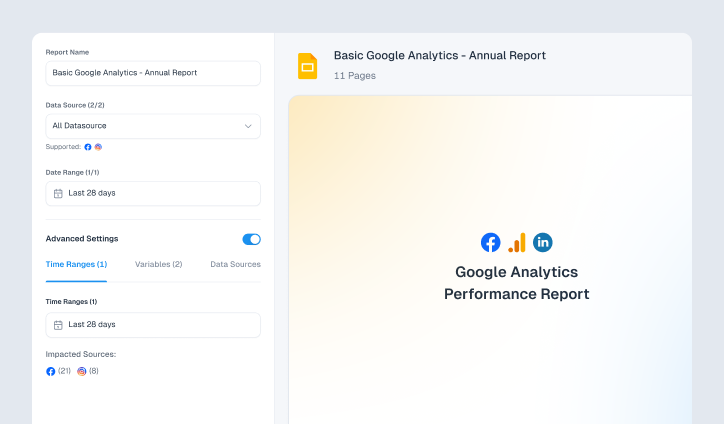
Custom Reports, Instant Insights
Generate tailored marketing reports effortlessly, delivering key insights in just a few clicks.
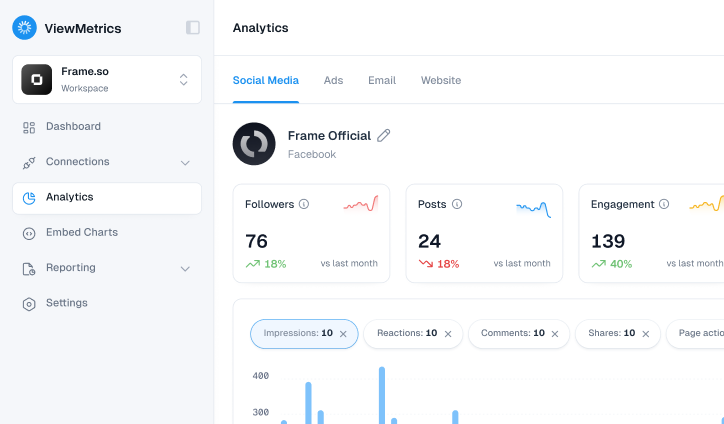
Actionable Analytics at a Glance
Access in-depth analytics to uncover trends, optimize strategies, and drive impactful decisions.

Collaborate with Ease
Invite team members to share insights, streamline workflows, and work together seamlessly.

Design That Stands Out
Elevate visuals effortlessly with customizable styling options tailored to match brand aesthetics.

Effortless Data Syncing
Keep insights up-to-date with seamless and flexible data synchronization across platforms.

Connect with Ease
Integrate effortlessly with leading platforms to streamline workflows and maximize efficiency.

Boost Productivity with Google Add-On
Access powerful tools directly within Google Workspace for seamless marketing reporting.

Custom Reports, Instant Insights
Generate tailored marketing reports effortlessly, delivering key insights in just a few clicks.

Actionable Analytics at a Glance
Access in-depth analytics to uncover trends, optimize strategies, and drive impactful decisions.

Collaborate with Ease
Invite team members to share insights, streamline workflows, and work together seamlessly.

Design That Stands Out
Elevate visuals effortlessly with customizable styling options tailored to match brand aesthetics.

Effortless Data Syncing
Keep insights up-to-date with seamless and flexible data synchronization across platforms.

Connect with Ease
Integrate effortlessly with leading platforms to streamline workflows and maximize efficiency.

Boost Productivity with Google Add-On
Access powerful tools directly within Google Workspace for seamless marketing reporting.

Custom Reports, Instant Insights
Generate tailored marketing reports effortlessly, delivering key insights in just a few clicks.

Actionable Analytics at a Glance
Access in-depth analytics to uncover trends, optimize strategies, and drive impactful decisions.

Collaborate with Ease
Invite team members to share insights, streamline workflows, and work together seamlessly.




